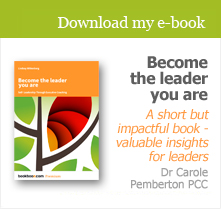Creating psychological safety for yourself

What is psychological safety?
Psychological safety is the belief that you won’t be punished, criticised, undermined or diminished for offering an opinion or an idea, pointing to an error that’s been made or will be made if something doesn’t change, asking for help, or speaking up in some other way.
Feeling unsafe
Feeling psychologically unsafe (and note: feeling unsafe doesn’t mean you actually are unsafe, but the feeling will dominate the facts) evokes a range of emotions and behaviours: anxiety, lack of trust, loss of motivation, indecisiveness, reticence, withdrawal and loss of engagement, to name but a few. It’s bad news for a team or an organisation.
Tom’s story
Tom (not his real name) was a highly accomplished leader, and, seeking to advance his career, he took a new role in a bigger organisation. His hope was that he would develop a more fulfilling work life and would achieve career progression on a larger scale.
However, once in the new role, he discovered that it – and especially working relationships – felt much more precarious than he had anticipated, and that the career progression he had sought and expected wasn’t either clear or assured. The opposite, in fact: despite being more than competent and capable, his sense was that behaviours in his working environment (including what he experienced as exclusively negative comments and criticisms from his line manager) suggested that not only was underperforming, but also that his role and contribution had no longevity.
He found these doubts and fears significantly unsettling, disappointing and worrying: he had invested emotionally and family-wise in the job move, and was beginning to question whether it had been wise. He was missing the trusted relationships that he had had in his previous organisation.
Enabling greater psychological safety
Harvard Business School Professor Amy Edmondson’s globally-recognised and ground-breaking work in The Fearless Organization brings insight to the experience and realisation of psychological safety, and allows it to be measured. She identifies four domains: inclusion and diversity, willingness to help, attitude to risk and failure, and open conversation. That measurement in a team can be debriefed, and the behavioural and attitudinal sources of the scores explored through facilitation that supports teams to capitalise on it and/or improve it: once a team is facilitated to be aware of the nature and extent of the psychological safety that characterises their day-to-day lives, they can also be facilitated to work together to develop practical plans to increase it – and thus increase creativity, innovation, effectiveness, collaboration, retention and other imperatives for business and organisational success. The leader is key to individuals enabling psychological safety for each other, of course.
Creating psychological safety for yourself
A different challenge arises when a team member experiences a lack of psychological safety, and when that very lack makes it impossible to share honestly with anyone, least of all with the leader, who may themselves be the source of the lack of safety. Dialogue feels impossible, and the individual can feel isolated and threatened, not knowing where or how to tread – as in Tom’s case.
How can an individual create more psychological safety for themselves in this kind of situation? How can they ensure their boundaries are clear and firm, how can they expand what Dr Dan Siegel calls their ‘window of tolerance’ (the range of emotion, thinking and behaviour within which an individual can function well)?
In my experience, there are a number of possible approaches that can help. All take effort and discipline.
Approaches that can help
The capacity to detach, to step back and let go of what might have you hooked, to separate from the triggers, can be invaluable, particularly when role or reputation, stress or wellbeing, feel like they’re at stake. Underpinning this capacity is self-awareness – awareness of what is actually going on somatically in the body, and the emotions and thinking (and judgments) which are thereby evoked, an understanding of the effect of one’s history and of experiences which may have been wounding in the past, and a consciousness of fears, doubts and challenges currently at play both in the immediate relationships involved and with relationships more broadly.
Inherent here is emotional intelligence: awareness of one’s own and others’ emotions, and the capacity to manage them in oneself and any impulse to react, as well as the capacity to manage others’ emotions.
Acceptance – agreeing to everything (not with everything) just as it is, because that’s what’s here now, can soothe inner anger and help bring effective cognitive reasoning back into play instead of resentment or anxiety. A mindfulness practice can contribute hugely to learning acceptance.
Linked to acceptance is compassion – for oneself and others. This, too, can defuse anxiety and help nurture more calm and fewer assumptions, stories and judgments.
Particularly tricky are power imbalances: the force of hierarchy, and the rights it confers explicitly and implicitly, can make it challenging to make one’s voice heard to a boss, for example. Transactional Analysis ego states may be a starting point: when a boss suggests in tone or words that their report is a naughty child, or their views aren’t valuable enough to be heard, attributing an Adult ego state to both them and oneself – rather than being in a Parent-Child interaction – can help to redress the balance. It also keeps things more objective and defuses emotional tension.
And finally, support. The sense of being alone and isolated is corrosive. Having trusted support at hand from a friend, uninvolved colleague or coach can go a long way to restoring confidence, clarity and tolerance, as well as acknowledging and recognising what is happening so that the individual feels validated.
All these approaches can nurture a sense of greater resource and resourcefulness. And with that comes a greater sense of safety.
Photo by Cytonn Photography via Unsplash


